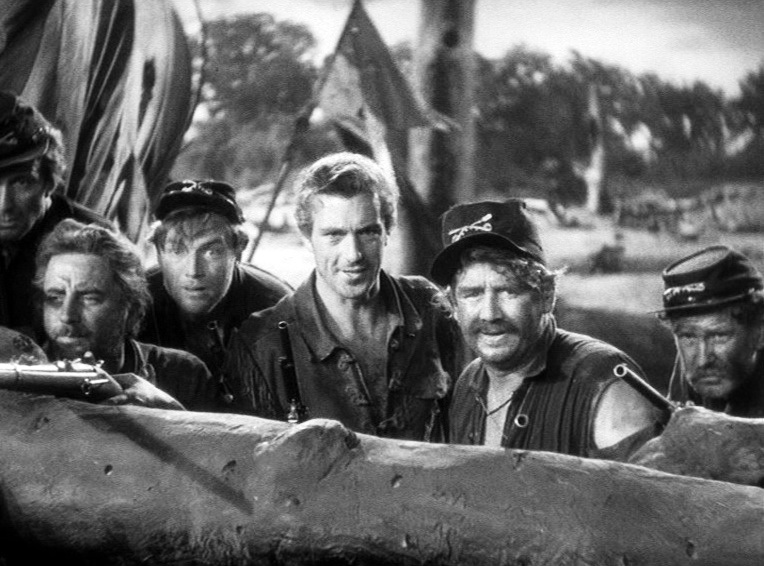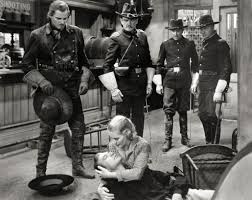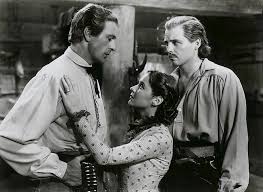🎬 The Plainsman (1936)

The Plainsman (1936) Review: A Sweeping Western Adventure with Larger-Than-Life Heroes
The Plainsman, directed by Cecil B. DeMille, is a classic Hollywood Western that blends historical drama, romance, and action. Featuring a star-studded cast led by Gary Cooper as Wild Bill Hickok and Jean Arthur as Calamity Jane, the film is a dramatized retelling of key events in the American frontier during the post-Civil War era. With its ambitious scope, thrilling action, and DeMille’s signature larger-than-life storytelling, The Plainsman is an enduring classic of the Western genre.
Plot Overview: Gunslingers, Pioneers, and Conflict
The film begins with the end of the Civil War, as Wild Bill Hickok (Gary Cooper) and Buffalo Bill Cody (James Ellison) work to bring order to the untamed American West. The central plot revolves around a conspiracy to arm Native American tribes with repeating rifles in an effort to escalate conflicts with settlers.
Hickok’s journey intersects with Calamity Jane (Jean Arthur), a fiery and independent woman who shares a deep, complicated bond with him. Alongside Buffalo Bill and General George Custer (John Miljan), they face treachery, ambushes, and gunfights in their quest to prevent chaos and protect the frontier.
Gary Cooper as Wild Bill Hickok: A Charismatic Hero
Gary Cooper delivers a commanding performance as Wild Bill Hickok, portraying him as a heroic yet human figure. Cooper’s natural charisma and understated acting style lend authenticity to the character, balancing Hickok’s confidence as a gunslinger with his vulnerability in personal relationships. His chemistry with Jean Arthur adds emotional depth to the story, making his portrayal of Hickok one of the film’s highlights.
Jean Arthur as Calamity Jane: A Strong, Spirited Counterpart
Jean Arthur shines as Calamity Jane, bringing humor, grit, and a touch of vulnerability to her role. Her portrayal of Jane emphasizes her independence and resourcefulness, creating a strong and complex female character who holds her own in a male-dominated world. Arthur’s dynamic with Cooper’s Hickok provides both comedic relief and emotional resonance, enriching the film’s narrative.
Supporting Cast: Adding Depth to the Frontier
- James Ellison as Buffalo Bill Cody: Ellison’s portrayal of Buffalo Bill is lively and engaging, providing a lighter counterpoint to Hickok’s stoicism. His camaraderie with Hickok and loyalty to the cause add warmth to the story.
- Charles Bickford as John Lattimer: Bickford plays the villainous gunrunner, a ruthless opportunist whose actions drive much of the conflict.
- John Miljan as General George Custer: Miljan’s portrayal of Custer is marked by ambition and arrogance, reflecting the complexities of his historical legacy.
- Porter Hall as Jack McCall: Hall’s performance as the infamous Jack McCall adds an air of menace, culminating in one of the film’s most dramatic moments.
Themes: Heroism, Expansion, and Morality
- Heroism and Sacrifice: The film emphasizes the bravery of frontier figures like Hickok, Cody, and Calamity Jane, portraying them as defenders of justice in a chaotic world.
- The Cost of Expansion: While romanticized, the film touches on the challenges and conflicts of westward expansion, particularly the tension between settlers, Native Americans, and opportunistic figures like Lattimer.
- Romance and Loyalty: The evolving relationship between Hickok and Jane explores themes of trust, love, and mutual respect, adding emotional weight to the narrative.

Direction and Cinematography: DeMille’s Grand Vision
Cecil B. DeMille’s direction brings his trademark grandeur to the film, blending large-scale action with intimate character moments. The cinematography by Victor Milner captures the sweeping landscapes of the American West, creating a vivid and immersive backdrop for the story. DeMille’s attention to detail in the production design enhances the historical atmosphere, even as the film takes liberties with historical accuracy.
Action and Pacing: Thrills and Drama
The film features several thrilling action sequences, including ambushes, shootouts, and a climactic confrontation that keeps viewers engaged. The pacing is steady, balancing character development with moments of high-stakes tension. While some scenes lean into melodrama, they are characteristic of the era and add to the film’s charm.
Historical Accuracy: A Romanticized Interpretation
Like many films of its time, The Plainsman takes significant liberties with historical events and characters for dramatic effect. The portrayal of Native Americans and their interactions with settlers reflects the biases of 1930s Hollywood, which may feel dated and problematic to modern audiences. However, the film’s focus on larger-than-life figures and its blend of fact and fiction are emblematic of DeMille’s storytelling style.
Key Moments That Define The Plainsman
- Hickok and Jane’s Banter: Their playful yet heartfelt interactions provide some of the film’s most memorable and emotionally resonant moments.
- The Gunrunning Plot: The conspiracy to arm Native Americans drives much of the film’s tension and highlights the moral complexities of the frontier.
- Hickok’s Final Stand: The dramatic climax, featuring Hickok’s iconic duel with Jack McCall, is both thrilling and poignant, solidifying his legendary status.
Strengths of The Plainsman
- Star Performances: Gary Cooper and Jean Arthur bring charisma and depth to their roles, anchoring the film with their dynamic chemistry.
- Epic Scope: DeMille’s direction and the film’s sweeping visuals create a sense of grandeur and adventure.
- Engaging Narrative: The blend of romance, action, and historical drama keeps the story compelling.

Weaknesses of The Plainsman
- Historical Liberties: The film’s romanticized depiction of events and figures may detract from its authenticity for history enthusiasts.
- Stereotypical Portrayals: The portrayal of Native Americans reflects the biases of its time, lacking nuance and complexity.
- Melodramatic Elements: Some scenes, particularly in the romantic subplot, may feel overly sentimental to modern audiences.
Legacy and Reception
The Plainsman was a commercial success and remains one of Cecil B. DeMille’s most celebrated Westerns. It contributed to the mythologizing of figures like Wild Bill Hickok and Calamity Jane, cementing their place in American folklore. While its historical inaccuracies are notable, the film’s grand storytelling and memorable performances ensure its enduring appeal.
Fun Facts About The Plainsman
- Gary Cooper’s Stardom: Cooper’s performance as Wild Bill Hickok helped solidify his status as a leading man in Hollywood.
- Jean Arthur’s Role: Arthur was cast against type as Calamity Jane, showcasing her range beyond romantic comedies.
- DeMille’s Influence: Known for his epic productions, DeMille brought a sense of spectacle to the Western genre with this film.
Conclusion: A Classic Western with Heart and Adventure
The Plainsman (1936) is a quintessential example of Golden Age Hollywood’s approach to the Western genre. With its larger-than-life characters, thrilling action, and sweeping scope, the film delivers an entertaining and emotionally resonant experience. While its historical liberties and dated elements may detract from its authenticity, its strong performances and grand vision make it a must-watch for fans of classic cinema and Western storytelling.